Abstract
The human tympanic membrane (TM) transfers sound in the ear canal into the mechanical vibration of the ossicles in the middle ear. The dynamic properties of TM directly affect the middle ear transfer function. The static or quasi-static mechanical properties of TM were reported in the literature, but the dynamic properties of TM over the auditory frequency range are very limited. In this paper, a new method was developed to measure the dynamic properties of human TM using the Dynamic-Mechanical Analyzer (DMA). The test was conducted at the frequency range of 1–40 Hz at three different temperatures: 5, 25, and 37 °C. The frequency-temperature superposition was applied to extend the testing frequency range to a much higher level (at least 3800 Hz). The generalized linear solid model was employed to describe the constitutive relation of the TM. The storage modulus E′ and the loss modulus E″ were obtained from 11 specimens. The mean storage modulus was 15.1 MPa at 1 Hz and 27.6 MPa at 3800 Hz. The mean loss modulus was 0.28 MPa at 1 Hz and 4.1 MPa at 3800 Hz. The results show that the frequency-temperature superposition is a feasible approach to study the dynamic properties of the ear soft tissues. The dynamic properties of human TM obtained in this study provide a better description of the damping behavior of ear tissues. The properties can be transferred into the finite element model of the human ear to replace the Rayleigh type damping. The data reported here contribute to the biomechanics of the middle ear and improve the accuracy of the FE model for the human ear.







Similar content being viewed by others
References
Aernouts, J., J. R. Aerts, and J. J. J. Dirckx. Mechanical properties of human tympanic membrane in the quasi-static regime from in situ point indentation measurements. Hear. Res., 2012. doi:10.1016/j.heares.2012.05.001.
Aernouts, J., and J. J. J. Dirckx. Static vs. dynamic gerbil tympanic membrane elasticity: derivation of the complex modulus. Biomech. Model. Mechanobiol., 2011. doi:10.1007/s10237-011-0355-6.
Aernouts, J., and J. J. J. Dirckx. Viscoelastic properties of gerbil tympanic membrane at very low frequencies. J. Biomech. 45:919–924, 2012.
Chan, R. W. Estimation of viscoelastic shear properties of vocal-fold tissues based on time-temperature superposition. J. Acoust. Soc. Am. 110:1548–1561, 2001.
Cheng, T., C. Dai, and R. Z. Gan. Viscoelastic properties of human tympanic membrane. Ann. Biomed. Eng. 35:305–314, 2007.
Daphalapurkar, N. P., C. Dai, R. Z. Gan, and H. Lu. Characterization of the linearly viscoelastic behavior of human tympanic membrane by nanoindentation. J. Mech. Behav. Biomed. Mater. 2:82–92, 2009.
Decraemer, W. F., M. A. Maes, and V. J. Vanhuyse. An elastic stress–strain relation for soft biological tissue based on a structural model. J. Biomech. 13:463–468, 1980.
Fay, J., S. Puria, W. F. Decraemer, and C. Steele. Three approaches for estimating the elastic modulus of the tympanic membrane. J. Biomech. 38:1807–1815, 2005.
Ferry, J. D. Mechanical properties of substances of high molecular weight. 6. Dispersion in concentrated polymer solutions and its dependence on temperature and concentration. J. Am. Chem. Soc. 72:3746–3752, 1950.
Ferry, J. D. Viscoelastic Properties of Polymer (3rd ed.). New York: Wiley, pp. 264–320, 1980.
Fung, Y. C. Biomechanics: Mechanical Properties of Living Tissues (2nd ed.). New York: Springer, pp. 260–263, 1993.
Gan, R. Z., B. Feng, and Q. Sun. Three-dimensional finite element modeling of human ear for sound transmission. Ann. Biomed. Eng. 32:847–859, 2004.
Gan, R. Z., B. P. Peeves, and X. Wang. Modeling of sound transmission from ear canal to cochlea. Ann. Biomed. Eng. 35:2180–2195, 2007.
Huang, G., N. P. Daphalapurkar, R. Z. Gan, and H. Lu. A method for measuring linearly viscoelastic properties of human tympanic membrane using nanoindentation. J. Biomech. Eng. 130:014501-1, 2008.
Kirikae, I. The Structure and Function of the Middle Ear. Tokyo: The University of Tokyo Press, 1960.
Kuyper, L. C., W. F. Decraemer, and J. J. J. Dirckx. Thickness distribution of fresh and preserved human eardrums measured with confocal microscopy. Otol. Neurotol. 27:256–264, 2006.
Lim, D. J. Structure and function of the tympanic membrane: a review. Acta Otorhinolaryngol. Belg. 49:101–115, 1995.
Luo, H., C. Dai, R. Z. Gan, and H. Lu. Measurement of Young’s modulus of human tympanic membrane at high strain rates. J. Biomech. Eng. 131:064501-1–8, 2009.
Mclaughlin, J., A. Thomas, and J. R. Yoon. Basic theory for generalized linear solid viscoelastic models. In: AMS Contemporary Mathematics Volume: Tomography and Inverse Transport Theory, edited by G. Bal, D. Finch, P. Kuchment, J. Schotland, P. Stefanov, and G. Uhlmann. Providence: American Mathematical Society, 2011, pp. 101–134.
Nielsen, L. E., and R. F. Landel. Mechanical Properties of Polymers and Composites (2nd ed.). New York: Marcel Dekker, 1994.
Peters, G. W. M., J. H. Meulman, and A. A. H. J. Sauren. The applicability of the time/temperature superposition principle to brain tissue. Biorheology 34:127–138, 1997.
Radebaugh, G. W., and A. P. Simonelli. Temperature-frequency equivalence of the viscoelastic properties of anhydrous lanolin USP. J. Pharm. Sci. 72:422–425, 1983.
Tajvidi, M., R. H. Falk, and J. C. Hermanson. Time-temperature superposition principle applied to a kenaf-fiber/high-density polyethylene composite. J. Appl. Polym. Sci. 97:1995–2004, 2005.
von Békésy, G. Experiments in Hearing. New York: McGraw-Hill Book Company, 1960.
von Unge, M., W. F. Decraemer, J. J. Dirckx, and D. Bagger-Sjöbäck. Displacement of the gerbil tympanic membrane under static pressure variations measured with a real-time differential moire interferometer. Hear. Res. 70:229–242, 1993.
Ward, I. M. Mechanical Properties of Solid Polymers. New York: Wiley, 1971.
Williams, M. L., R. F. Landel, and J. D. Ferry. Temperature dependence of relaxation mechanisms in amorphous polymers and other glass-forming liquids. Phys. Rev. 98:1549–1549, 1955.
Zhang, X., and R. Z. Gan. Dynamic properties of human tympanic membrane-experimental measurement and modeling analysis. Int. J. Exp. Comput. Biomech. 1:252–270, 2010.
Zhang, X., and R. Z. Gan. A comprehensive model of human ear for analysis of implantable hearing devices. IEEE Trans. Biomed. Eng. 58(10):3024–3027, 2011.
Zhao, F., T. Koike, J. Wang, H. Sienz, and R. Meredith. Finite element analysis of the middle ear transfer functions and related pathologies. Med. Eng. Phys. 31(8):907–916, 2009.
Acknowledgments
The authors thank the technical assistance on the TM sample preparations from Don Nakmali at Hough Ear Institute, Oklahoma City. This work was supported by NIH R01DC006632 and R01DC011585.
Author information
Authors and Affiliations
Corresponding author
Additional information
Associate Editor Sean S. Kohles oversaw the review of this article.
Rights and permissions
About this article
Cite this article
Zhang, X., Gan, R.Z. Dynamic Properties of Human Tympanic Membrane Based on Frequency-Temperature Superposition. Ann Biomed Eng 41, 205–214 (2013). https://doi.org/10.1007/s10439-012-0624-2
Received:
Accepted:
Published:
Issue Date:
DOI: https://doi.org/10.1007/s10439-012-0624-2




